Strain Behavior of Nickel Alloy 200 during Multiaxial Forging through Finite Element Modeling
Abstract
1. Introduction
2. Experimental Work
2.1. TEM Microscopy Examination
2.2. Hardness Uniformity
2.3. Finite Element Modeling
3. Results and Discussion
3.1. Effect of Strain Rate
3.2. Effect of Temperature
3.3. Effect of Friction
4. Conclusions
- The average crystallite size was reduced from 805 ± 22 nm at the annealed condition to the 220 ± 16 nm after three cycles of the MAF process.
- The results of hardness measurement showed an increase of 175% after three cycles of the MAF process. The inhomogeneity factor (IF) calculated on the basis of hardness measurement decreased by 40% with the three cycles of MAF.
- The inhomogeneous factor (IF) decreased with increasing the strain rate. It can be said that a more homogeneous structure and, hence, more uniform mechanical properties are possible by imposing severe strain at a high rate.
- When the initial temperature increased, inhomogeneity in the structure decreased.
- The deformation process is expected to induce local strain inhomogeneity and to increase the intergranular stresses. Further, single crystals anisotropy could upturn local inhomogeneity.
- Inhomogeneity decreased with an increase of strain rate sensitivity and was enhanced by an increase of the density of material and a larger rate of elongation.
- The increase of temperature is linearly fit with the slope of the strain rate versus effective strain. In addition, the increase of the strain rate is independent from the true strain at a medium temperature, while it fits on positive linear proportionality.
- At a low strain rate, the friction affected MAF significantly. Then, the effect of friction reduced intensely with the increase of the strain rate. However, the effect of friction on true stress was almost independent from strain rate variation.
Author Contributions
Funding
Conflicts of Interest
References
- Valiev, R.Z.; Langdon, T.G. Principles of equal-channel angular pressing as a processing tool for grain refinement. Prog. Mater. Sci. 2006, 51, 881–981. [Google Scholar] [CrossRef]
- Langdon, T.G. Twenty-five years of ultrafine-grained materials: Achieving exceptional properties through grain refinement. Acta Mater. 2013, 61, 7035–7059. [Google Scholar] [CrossRef]
- Ebrahimi, M.; Attarilar, S.; Djavanroodi, F.; Gode, C.; Kim, H.S. Wear properties of brass samples subjected to constrained groove pressing process. Mater. Des. 2014, 63, 531–537. [Google Scholar] [CrossRef]
- Sakai, T.; Belyakov, A.; Kaibyshev, R.; Miura, H.; Jonas, J.J. Dynamic and post-dynamic recrystallization under hot, cold and severe plastic deformation conditions. Prog. Mater. Sci. 2014, 60, 130–207. [Google Scholar] [CrossRef]
- Ebrahimi, M.; Djavanroodi, F.; Tiji, S.A.N.; Gholipour, H.; Gode, C. Experimental Investigation of the Equal Channel Forward Extrusion Process. Metals 2015, 5, 471–483. [Google Scholar] [CrossRef]
- Hussain, Z.; Al-Mufadi, F.A.; Subbarayan, S.; Irfan, O.M. Microstructure and mechanical properties investigation on nanostructured Nickel 200 alloy using multi-axial forging. Mater. Sci. Eng. A 2018, 712, 772–779. [Google Scholar] [CrossRef]
- Chen, Q.; Shu, D.; Hu, C.; Zhao, Z.; Yuan, B. Grain refinement in an as-cast AZ61 magnesium alloy processed by multi-axial forging under the multi temperature processing procedure. Mater. Sci. Eng. A 2012, 541, 98–104. [Google Scholar] [CrossRef]
- Kapoor, R.; Sarkar, A.; Yogi, R.; Shekhawat, S.K.; Samajdar, I.; Chakravartty, J.K. Softening of Al during multi-axial forging in a channel die. Mater. Sci. Eng. A 2013, 560, 404–412. [Google Scholar] [CrossRef]
- Hussain, M.; Rao, P.N.; Singh, D.; Jayaganthan, R.; Singh, S. Comparative study of Microstructure and Mechanical properties of Al 6063 alloy Processed by Multi axial forging at 77K and Cryorolling. Procedia Eng. 2014, 75, 129–133. [Google Scholar] [CrossRef]
- Milind, P.P.; Date, T.R. Analytical and finite element modeling of strain generated in equal channel angular extrusion. Int. J. Mech. Sci. 2012, 56, 26–34. [Google Scholar] [CrossRef]
- Valiev, R.Z.; Estrin, Y.; Horita, Z.; Langdon, T.G.; Zehetbauer, M.J.; Zhu, Y.T. Producing bulk ultrafine-grained materials by severe plastic deformation. JOM 2006, 58, 33–39. [Google Scholar] [CrossRef]
- Kundu, A.; Kapoor, R.; Tewari, R.; Chakravartty, J.K. Severe plastic deformation of copper using multiple compression in a channel die. Scr. Mater. 2008, 58, 235–238. [Google Scholar] [CrossRef]
- Monzon, M.D.; Marrero, M.D.; Benitez, A.N.; Hernandez, P.M.; Cardenes, J.F. A technical note on the characterization of electroformed nickel shells for their application to injection molds. J. Mater. Process. Technol. 2006, 176, 273–277. [Google Scholar] [CrossRef]
- Zhao, Y.; Topping, T.; Bingert, J.F.; Thornton, J.J.; Dangelewicz, A.M.; Li, Y.; Liu, W.; Zhu, Y.; Zhou, Y.; Lavernia, E.J. High tensile ductility and strength in bulk nanostructured nickel. Adv. Mater. 2008, 20, 3028–3033. [Google Scholar] [CrossRef]
- Du, T.; Vijayakumar, A.; Sundaram, K.B.; Desai, V. Chemical mechanical polishing of nickel for applications in MEMS devices. Mater. Lett. 2004, 58, 2306–2309. [Google Scholar] [CrossRef]
- Kumar, S.S.S.; Priyasudha, K.; Rao, M.S.; Raghu, T. Deformation homogeneity, mechanical behaviour and strain hardening characteristics of titanium severe plastically deformed by cyclic channel die compression method. Mater. Des. 2016, 101, 117–129. [Google Scholar] [CrossRef]
- Shaeri, M.H.; Djavanroodi, F.; Sedighi, M.; Ahmadi, S.; Salehi, M.T.; Seyyedein, S.H. Effect of copper tube casing on strain distribution and mechanical properties of Al-7075 alloy processed by equal channel angular pressing. J. Strain Anal. 2013, 48, 512–521. [Google Scholar] [CrossRef]
- Djavanroodi, F.; Daneshtalab, M.; Ebrahimi, M. A novel technique to increase strain distribution homogeneity for ECAPed. Mater. Sci. Eng. A 2012, 535, 115–121. [Google Scholar] [CrossRef]
- Djavanroodi, F.; Ebrahimi, M. Effect of die parameters and material properties in ECAP with parallel channels. Mater. Sci. Eng. A Struct. 2010, 527, 7593–7599. [Google Scholar] [CrossRef]
- Yoon, S.C.; Quang, P.; Hong, S.I.; Kim, H.S. Die design for homogeneous plastic deformation during equal channel angular pressing. J. Mater. Process. Technol. 2007, 187–188, 46–50. [Google Scholar] [CrossRef]
- Ebrahimi, M.; Rajabifar, B.; Djavanroodi, F. New approaches to optimize strain behavior of Al6082 during equal channel angular pressing. J. Strain Anal. 2013, 48, 395–404. [Google Scholar] [CrossRef]
- Wang, S.; Liang, W.; Wang, Y.; Bian, L.; Chen, K. A modified die for equal channel angular pressing. J. Mater. Process. Technol. 2009, 209, 3182–3186. [Google Scholar] [CrossRef]
- Qian, D.; Pan, Y. 3D coupled macro–microscopic finite element modelling and simulation for combined blank-forging and rolling process of alloy steel large ring. Comput. Mater. Sci. 2013, 70, 24–36. [Google Scholar] [CrossRef]
- Han, Y.; Yan, S.; Sun, Y.; Chen, H. Modeling the Constitutive Relationship of Al–0.62Mg–0.73Si Alloy Based on Artificial Neural Network. Metals 2017, 7, 114. [Google Scholar] [CrossRef]
- Casalino, G.; Facchini, F.; Mortello, M.; Mummolo, G. ANN modelling to optimize manufacturing processes: The case of laser welding. IFAC Proc. 2016, 49, 378–383. [Google Scholar] [CrossRef]
- Casalino, G.; Losacco, A.M.; Arnesano, A.; Facchini, F.; Pierangeli, M.; Bonserio, C. Statistical Analysis and Modelling of an Yb: KGW Femtosecond Laser Micro-drilling Process. Procedia CIRP 2017, 62, 275–280. [Google Scholar] [CrossRef]
- Djavanroodi, F.; Omranpour, B.; Sedighi, M. Artificial Neural Network Modeling of ECAP Process. Mater. Manuf. Process. 2013, 28, 276–281. [Google Scholar] [CrossRef]
- Kwapisz, M.; Knapinski, M.; Dyja, H.; Laber, K. Analysis of the Effect of the Tool Shape on the Stress and Strain Distribution in the Alternate Extrusion and Multiaxial Compression Process. Arch. Metall. Mater. 2011, 56, 487–493. [Google Scholar] [CrossRef]
- Suo, T.; Li, Y.; Deng, Q. Optimal pressing route for continued equal channel angular pressing by finite element analysis. Mater. Sci. Eng. A Struct. 2007, 466, 166–171. [Google Scholar] [CrossRef]
- Ghanbari, B.F.; Arabi, H.; Abbasi, S.M.; Boutorabi, S.M.A. Manufacturing of nanostructured Ti-6Al-4V alloy via closed-die isothermal multi-axial-temperature forging: Microstructure and mechanical properties. Int. J. Adv. Manuf. Technol. 2016, 87, 755–763. [Google Scholar] [CrossRef]
- Banerjee, A.; Dhar, S.; Acharyya, S.; Datta, D.; Nayak, N. Determination of Johnson cook material and failure model constants and numerical modelling of Charpy impact test of armour steel. Mater. Sci. Eng. A 2015, 640, 200–209. [Google Scholar] [CrossRef]
- Zhang, Y.-B.; Yao, S.; Hong, X.; Wang, Z.-G. A modified Johnson–Cook model for 7N01 aluminum alloy under dynamic condition. J. Cent. South Univ. 2017, 24, 2550–2555. [Google Scholar] [CrossRef]
- Rajendran, A.; Grove, D.J.; Dietenberger, M.; Cook, W.H. A Dynamic Failure Model for Ductile Materials; Air Force Systems Command: Florida, USA, 1991. [Google Scholar]
- Nickel-Properties, Fabrication and Applications of Commercially Pure Nickel. Available online: https://www.azom.com/properties.aspx?ArticleID=2193 (accessed on 15 August 2018).
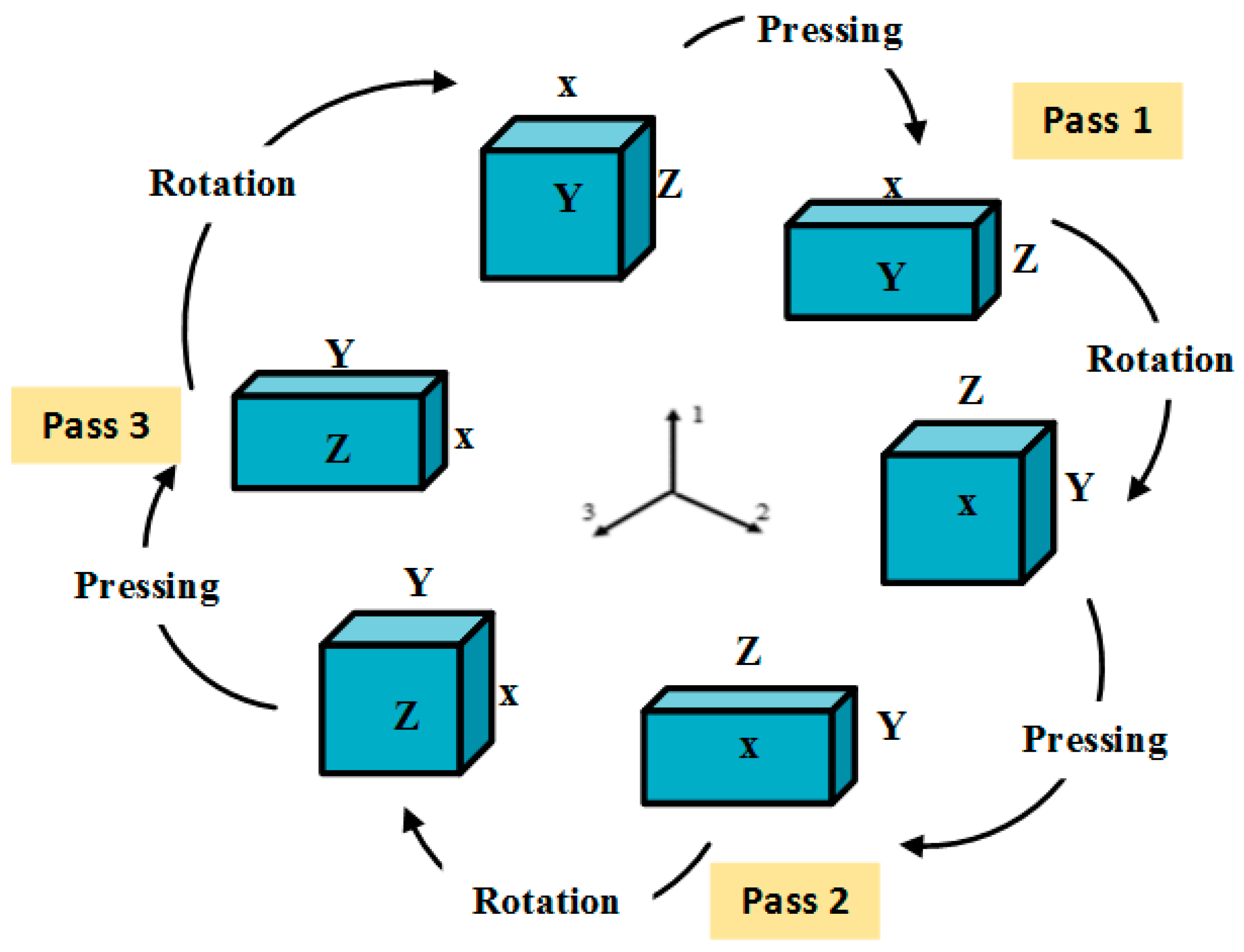

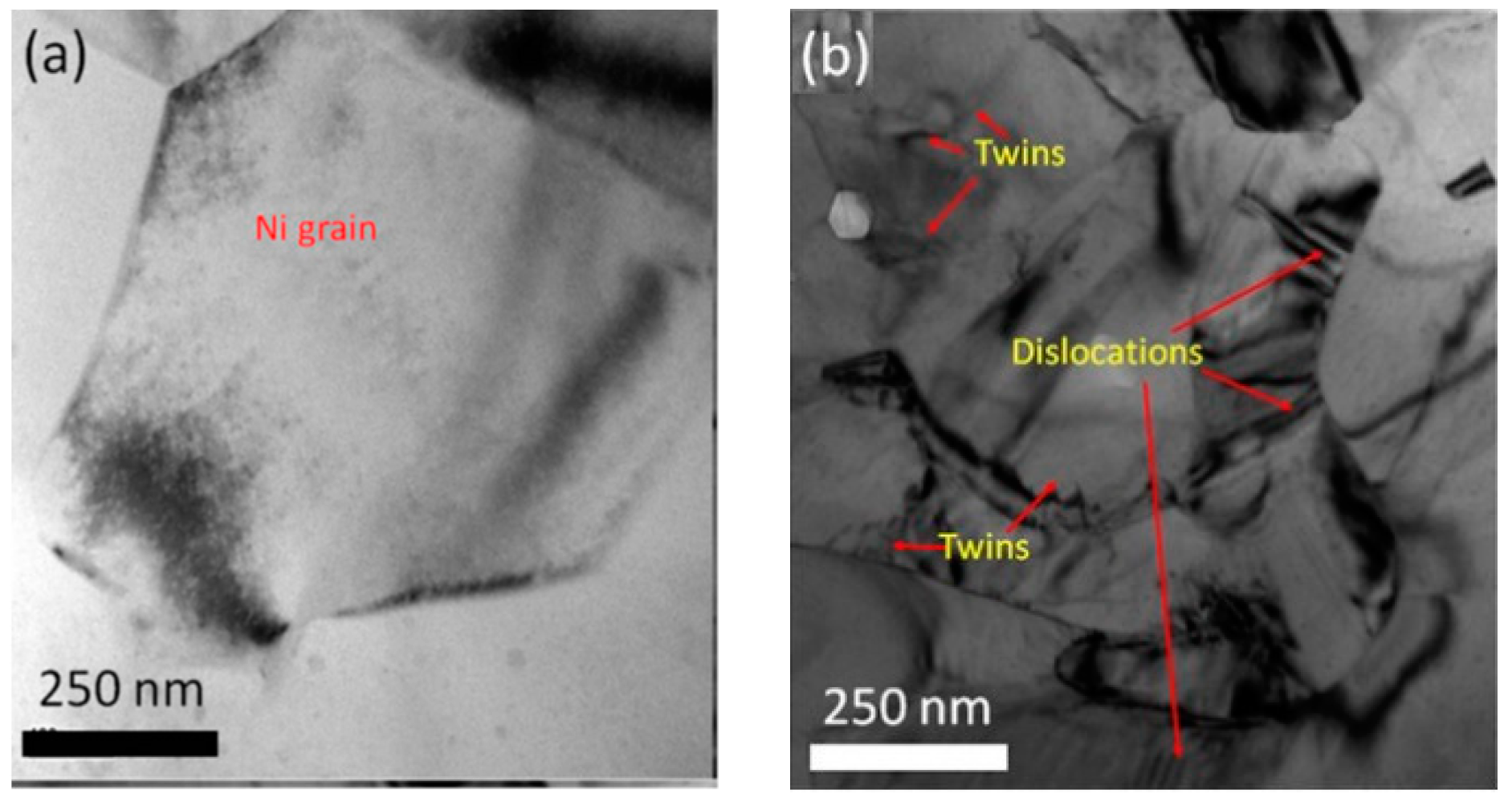
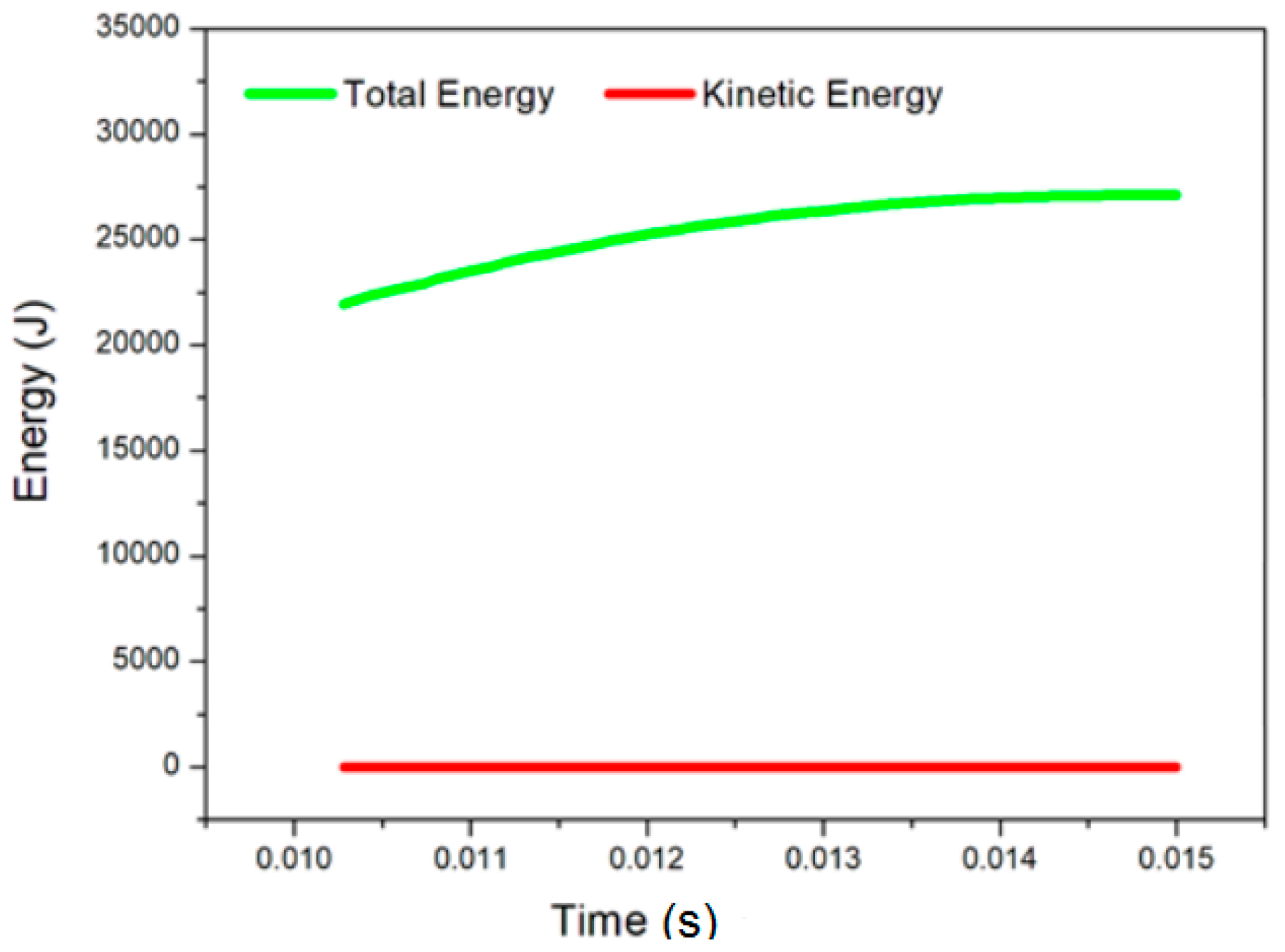
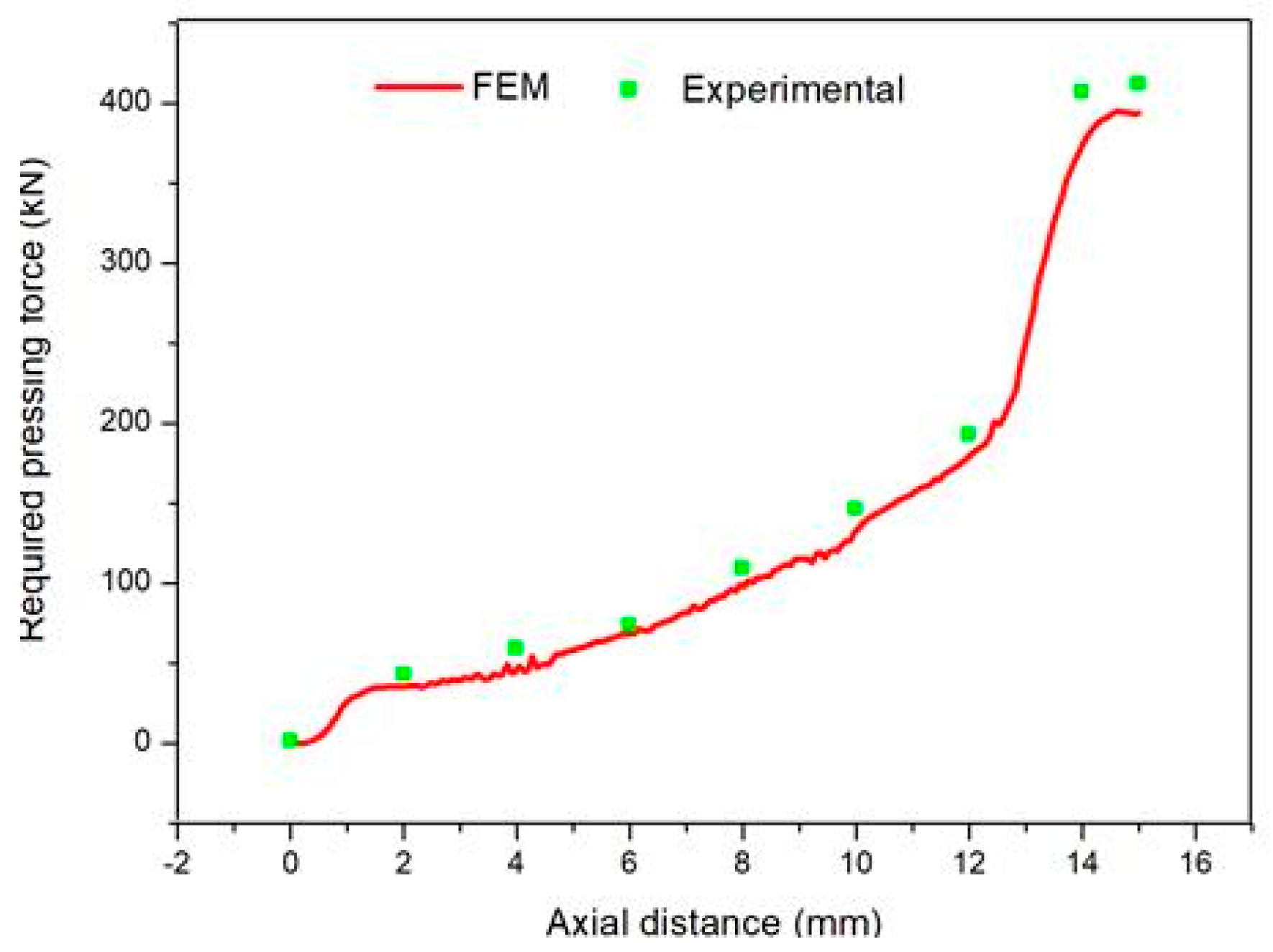
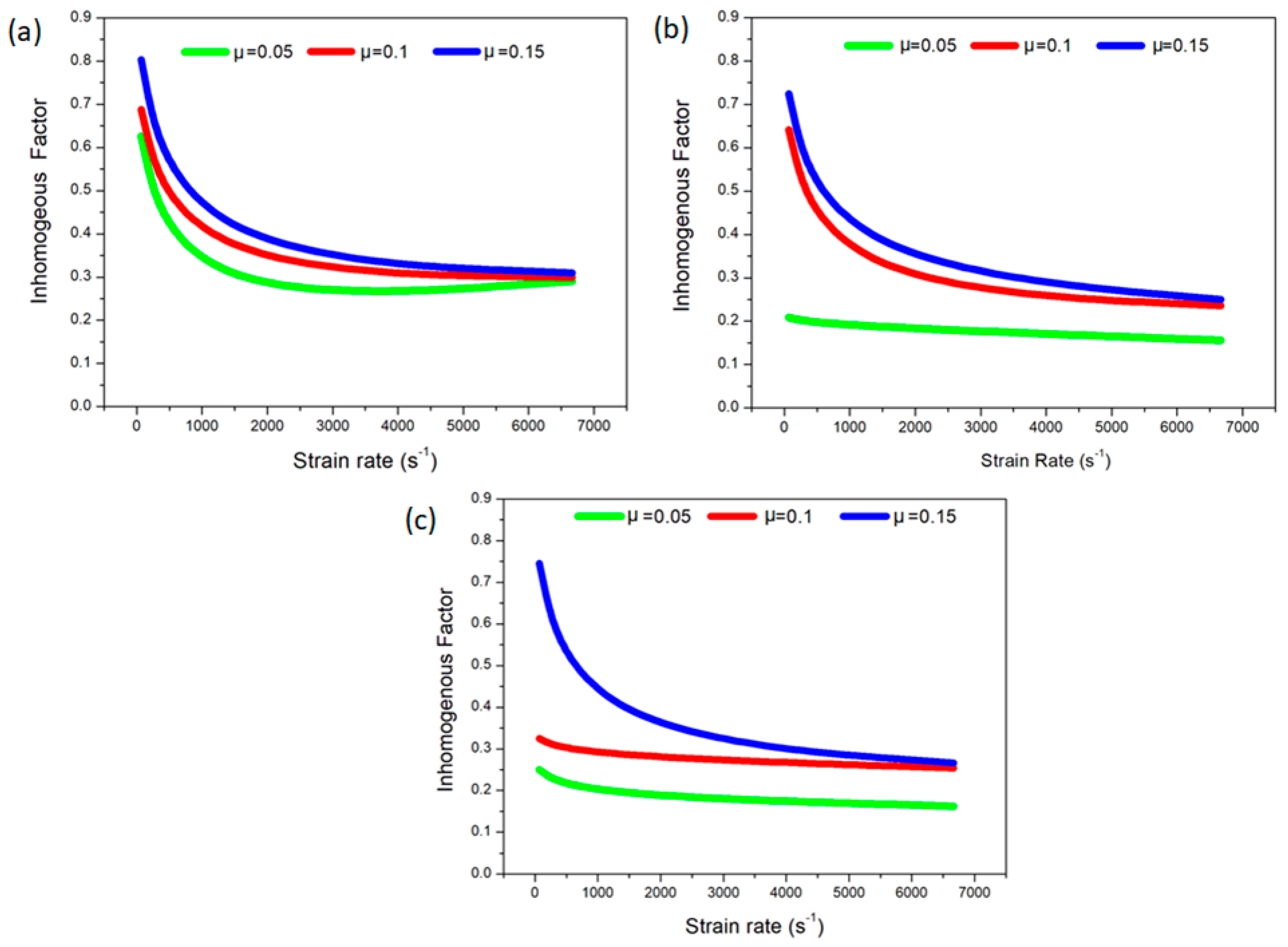
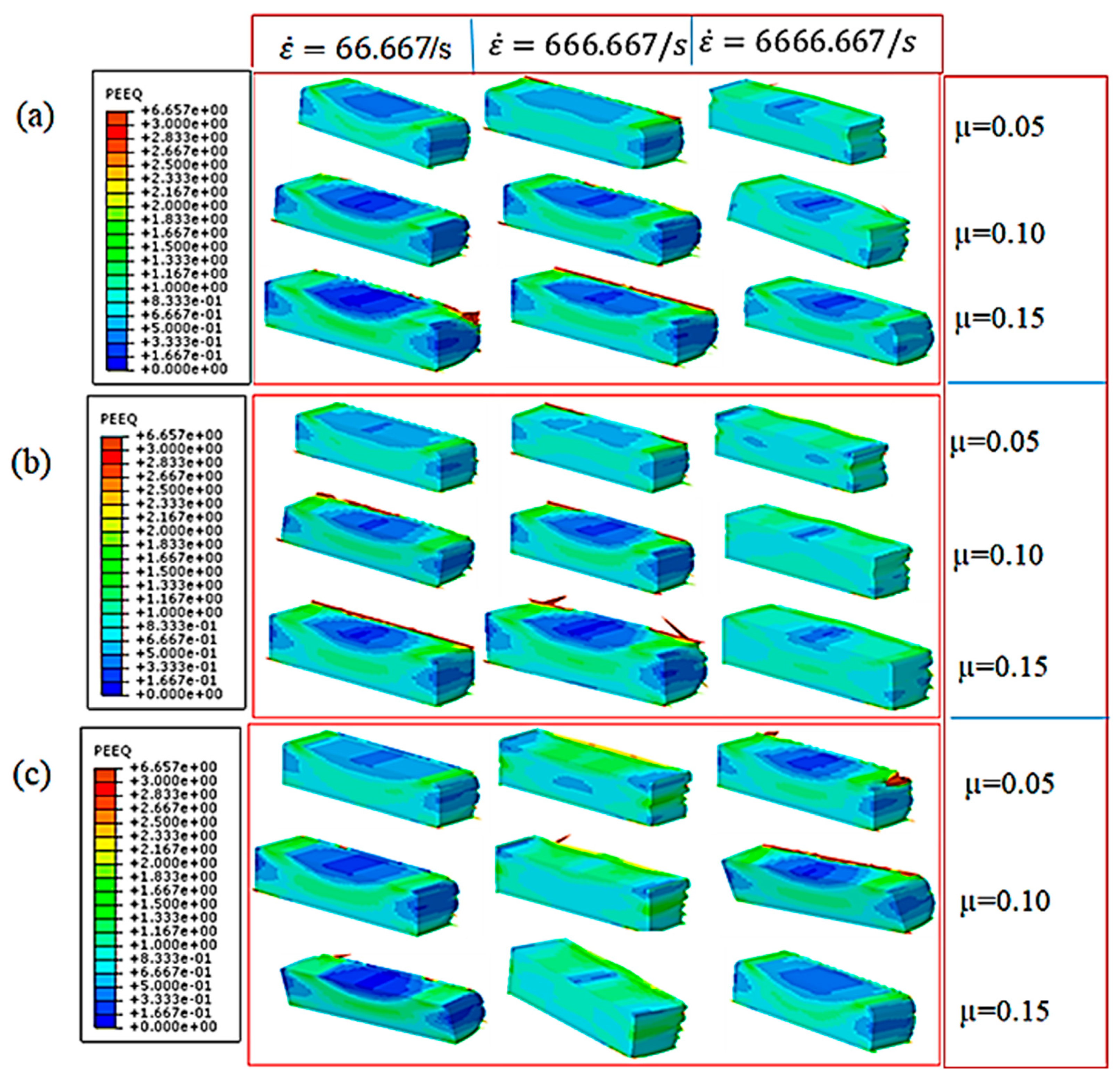
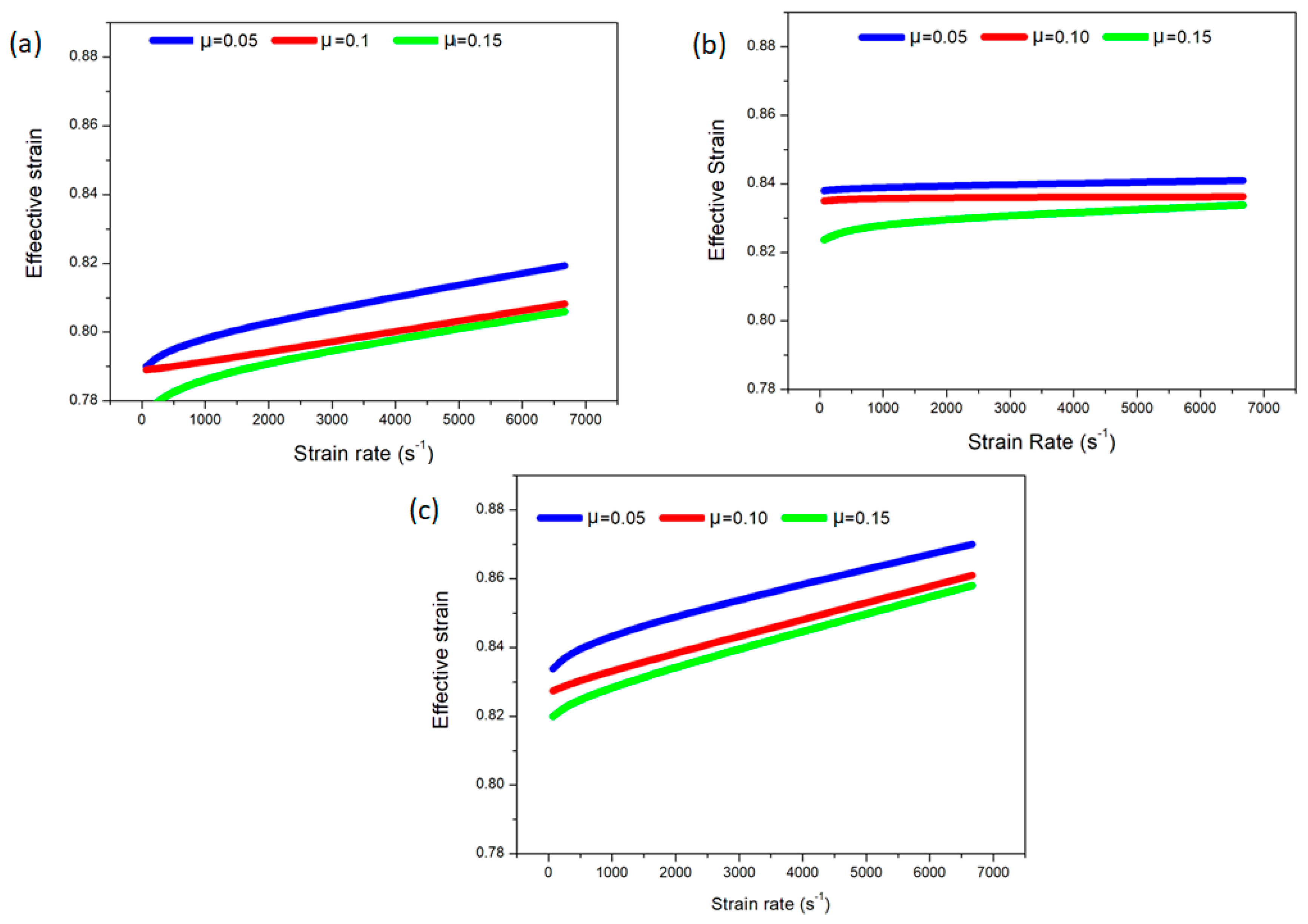
| Element | Ni | Cu | Mn | Si | C | Mg | S | Fe | Pb |
|---|---|---|---|---|---|---|---|---|---|
| Weight (%) | 99.5 | 0.01 | 0.002 | 0.01 | 0.01 | <0.005 | <0.002 | 0.02 | <0.002 |
| Test Samples | Vicker’s Hardness (Hv) | IF (%) |
|---|---|---|
| 0 cycle of MAF | 121.2 ± 17 | 63.9 |
| 1 cycle of MAF | 260.6 ± 14 | 48.7 |
| 2 cycle of MAF | 305.9 ± 16 | 35.8 |
| 3 cycle of MAF | 330.7 ± 13 | 21.7 |
| A | B | C | n | m | Melting Temperature |
|---|---|---|---|---|---|
| 163.4 MPa | 648.10 MPa | 0.006 | 0.33 | 1.44 | 1465 °C |
| Elastic Modulus | Poisson’s Ratio | Density | Specific Heat |
|---|---|---|---|
| 210 GPa | 0.3 | 8.908 g/cm3 | 456 J/kg·K |
| Independent Parameters (Inputs) | Values | Outputs |
|---|---|---|
| Strain Rate | 66.7 s−1 (Quasi-static) | Effective Strain (ES) |
| 666.67 s−1 | ||
| 6666.67 s−1 | ||
| Temperature | 25 °C | |
| 250 °C | ||
| 500 °C | ||
| Coefficient of friction | 0.05 | Inhomogeneous Factor (IF) Via strain distribution |
| 0.1 | ||
| 0.15 |
© 2019 by the authors. Licensee MDPI, Basel, Switzerland. This article is an open access article distributed under the terms and conditions of the Creative Commons Attribution (CC BY) license (http://creativecommons.org/licenses/by/4.0/).
Share and Cite
Djavanroodi, F.; Hussain, Z.; Irfan, O.M.; Al-Mufadi, F. Strain Behavior of Nickel Alloy 200 during Multiaxial Forging through Finite Element Modeling. Metals 2019, 9, 132. https://doi.org/10.3390/met9020132
Djavanroodi F, Hussain Z, Irfan OM, Al-Mufadi F. Strain Behavior of Nickel Alloy 200 during Multiaxial Forging through Finite Element Modeling. Metals. 2019; 9(2):132. https://doi.org/10.3390/met9020132
Chicago/Turabian StyleDjavanroodi, Faramarz, Zahid Hussain, Osama M. Irfan, and Fahad Al-Mufadi. 2019. "Strain Behavior of Nickel Alloy 200 during Multiaxial Forging through Finite Element Modeling" Metals 9, no. 2: 132. https://doi.org/10.3390/met9020132
APA StyleDjavanroodi, F., Hussain, Z., Irfan, O. M., & Al-Mufadi, F. (2019). Strain Behavior of Nickel Alloy 200 during Multiaxial Forging through Finite Element Modeling. Metals, 9(2), 132. https://doi.org/10.3390/met9020132





